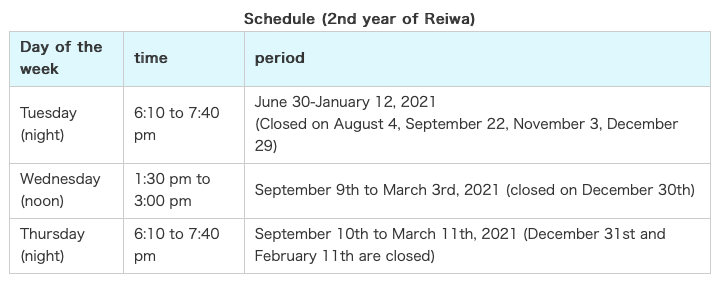There are a lot of resources for studying languages especially Japanese. From Youtube to Instagram, just to name a few. But if what you’re looking for is free of charge and learning it from the locals, then you came to the right place. This is your chance if you’re on a tight budget and you wish to have free Japanese lessons taught by a local while living in Japan. These are offered by the non-profit exchange associations in the country.
I’m currently residing in Nagasaki so, let me share with you the setup here as I’m more familiar with it than the other prefectures’ arrangement.
Class Schedule
The schedule varies from each prefecture. In Nagasaki, they offer the class once a week every Tuesday, Wednesday, and Thursday. You’re free to choose the schedule that’s best for you. See the photo below for your reference.

If you’re a student or an employee who needs to stay at work or school until 6 PM, there’s no need to worry about being late. I get it, the Japanese frown upon tardiness, but in this case, they understand. Just let them know about your situation.
Cost
I know I just stated that it’s free so why mentioned the cost? Well, when something is free, there’s a tendency that there is a catch. I assume you get what I’m trying to say?
Anyway, the sessions are free of charge. True story. You don’t need to pay for a fee. But, yes there’s a ‘but’. A tiny ‘but’. You have to buy the textbooks that you’re going to use. It’ll cost you 2,970 yen. Does it sound discouraging to you? Then let me give you a little pick-me-up. I did buy the textbooks and the site stated it’s required, but, I guess some students weren’t forced. Not sure about it. Sorry, it’s supposed to be a pick-me-up. How about this? Just remember that if you study in a language school, it’ll cost you more than the amount mentioned.
Learning Materials
If you have the materials you’ve been using when self-studying, take them with you to your classes. In case you don’t have any and you opt-out buying the textbooks, please ask the staff if you can. What I’m sure about is you can borrow them. Just return them after the session.
Who are the teachers?
Did I mention about locals? Yes. These free lessons are handled by local volunteers from different walks of life. They come from different professions as well as ages. Some are still students while others are already in the prime of their lives.
When it comes to their English skills, not all of them are fluent. I had one teacher who was. My current teacher however is neither fluent nor a beginner. Does English fluency matter? I would say not really. If I have to weigh it in the balance here’s what I’m gonna have to say.
A teacher who is fluent in English may be an advantage as she can explain the grammar points clearly. Especially if they can compare it to how we do it in English. Well, that’s one way I learn faster. The downside is the tendency she’ll converse with you mostly in English. On the other hand, a teacher who isn’t that fluent may not be able to explain the grammar points clearly in English. Of course, she can in Japanese. Though for beginners, an English explanation has a huge impact. So, while she might not be able to do that in English, the merit is you’ll get to converse with her only in Japanese which sounds like a good practice.
Japanese Level
These non-profit organizations mainly cater to beginners. If you’re intermediate, you’re still eligible to be in. They accept anyone regardless of the Japanese proficiency level.
How does it work?
It is a face-to-face lesson. The ratio, however, depends on the number of students and the teachers. In some cases, it’s one teacher to two students or two teachers to one student.
Location
Since it’s a face-to-face setup, classes are held at a community facility or a government establishment. Because of the pandemic, my teacher suggested doing the classes online via Skype a few months back. It was so kind of her. Now that the government has eased the rules, we’re back to where we usually do the classes.
How to apply?
Online Registration
The first thing you need to do is search for free Japanese lessons on the web. Be sure to check the one from your prefecture. Then, look for the link that direct you to the application site.
Official Site for Nagasaki’s International Beginner Course
Offline
You can go directly to the venue on the day of the class and fill out the application form. But if you found the site on the web, it would be better to do it there.
Is it worth it?
No doubt about it. Aside from the fact that it’s free, you’ll also get to meet new friends and socialize with the locals. There’s no better way of acing your Nihongo skills than talking with the locals.
Likewise, these non-profit exchange associations conduct events to promote a good relationship with the foreign nationals. Most of the events are related to Japanese culture. Students are invited to partake but, you can also opt-out if you don’t feel like being with the crowd.
List of free Japanese lessons by prefecture
I chanced upon this site that contains links to the free Japanese lessons by prefecture. Please click the word ‘site’. By the way, some prefectures may not have this program.
Happy learning! I hope you found this post helpful.
